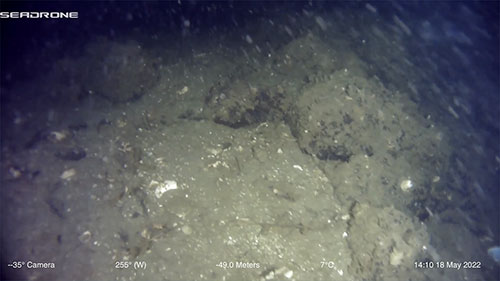Image from a remotely operated vehicle (ROV) of semi-circular stacked stones on the seafloor, part of a larger weir complex. |
The age of the weir, which was found in Shakan Bay on the west side of Prince of Wales Island, pushes back Native occupation of the region by more than 1,000 years, said SHI Rosita Worl, noting previous scientific studies have confirmed that Indigenous people lived in Southeast Alaska at least 10,000 years ago.
“It further substantiates the great antiquity of Native people in Southeast Alaska. It also demonstrates that Native people had acquired knowledge about salmon behavior and migrations, then developed the technology to harvest a significant number of salmon,” Worl said.
“I am excited that we are able to use science and technology to substantiate our beliefs and oral traditions that say we have lived in Southeast Alaska since time immemorial and to incorporate our knowledge into these narratives,” she said.
One scientist affiliated with the project said she suspects that people were in Southeast Alaska a few thousand years prior to the construction of the weir.
Stone weirs, or tidal fish traps, were typically low arced walls made of boulders and sited across gullies. The weirs were built so that during high tide, the fish would swim over the stone walls, and as the tide ebbed, the fish would be trapped behind them, allowing fishers to catch them with nets, spears and other means.
Fish weirs — which also were made of other materials, such as reeds or wooden posts — were commonly used around the world in ancient times, and other stone weirs have been documented in Southeast Alaska. However, this is by far the oldest one ever found, and it is the first one ever confirmed underwater in North America.
The structure was first found in 2010 by use of side-scan sonar technology, which detects and images objects on the seafloor. Scientists suspected the vague image to be that of a stone weir, but mostly due to funding constraints, the team was not able to confirm their hypothesis through underwater exploration until earlier this year, said Dr. Kelly Monteleone (co-PI), an archaeologist at the University of Calgary.
“The entire vessel was bouncing with excitement when we realized it was indeed a weir,” said Monteleone, who was piloting the underwater craft that helped confirm the existence of the trap. “Personally, I felt relief after a decade of saying this was a weir. Finally confirming the location was satisfying and exhilarating.”
The actual age of the weir is determined based on sea level reconstruction to be approximately 11,1000 years, Monteleone said.
“The extrapolated 11,100-year date is actually quite late. I anticipate we will find evidence in Southeast Alaska that dates it to at least 16,000 years ago,” she said.
Worl said the find suggests Native people occupied the area much longer than 11,100 years ago.
“It would have taken time for our people to learn enough about the environment and fish behavior to develop the technology to make the weir and to fish it successfully,” Worl said.
Prior to the discovery, the oldest known weirs dated from 7,5000 to 8,000 years ago, according to an article in ThoughtCo., and education website of stories written by writers with advanced degrees in subject areas. The oldest dated weir in Southeast Alaska is 5,740 to 5,490 calendar years old, said Monteleone.
This project brings together a highly experienced team from around North America organized by Sunfish Inc. and Sealaska Heritage Institute. The team includes: Dr. Kristof Richmond (PI), Chief Technology Officer at Sunfish Inc.; Dr. Kelly Monteleone (co-PI), an archaeologist at the University of Calgary; Dr. Rosita Worl, an anthropologist from Sealaska Heritage Institute; Dr. Vera Pospelova, who specializes in dinoflagellate Cyst analysis from the University of Minnesota; Dr. Nancy Bigelow, who specializes in microfossil and pollen analysis from the University of Alaska, Fairbanks; Jill Heinerth, the lead diver and Education/Outreach specialist; Vickie Siegel, the field operations manager for Sunfish; and additional Sunfish team members. The project will hire local residents to participate, and tribal representation will be coordinated through Sealaska Heritage Institute. SHI also plans to bring interns majoring in sciences. Additionally, National Oceanic and Atmospheric Administration, United States Geological Survey, and Tongass National Forest Service representatives will continue to participate throughout the project.
| This article is provided to the news media by Sealaska Heritage Institute, a private nonprofit founded in 1980 to perpetuate and enhance Tlingit, Haida and Tsimshian cultures of Southeast Alaska. Its goal is to promote cultural diversity and cross-cultural understanding through public services and events. SHI also conducts social scientific and public policy research that promotes Alaska Native arts, cultures, history and education statewide. The institute is governed by a Board of Trustees and guided by a Council of Traditional Scholars, a Native Artist Committee and a Southeast Regional Language Committee. |
Representations of fact and opinions in comments posted are solely those of the individual posters and do not represent the opinions of Sitnews.
Send a letter to the editor@sitnews.us
SitNews ©2022
Stories In The News
Ketchikan, Alaska
Articles & photographs that appear in SitNews are considered protected by copyright and may not be reprinted without written permission from and payment of any required fees to the proper freelance writers and subscription services.
E-mail your news & photos to editor@sitnews.us
Photographers choosing to submit photographs for publication to SitNews are in doing so granting their permission for publication and for archiving. SitNews does not sell photographs. All requests for purchasing a photograph will be emailed to the photographer.

